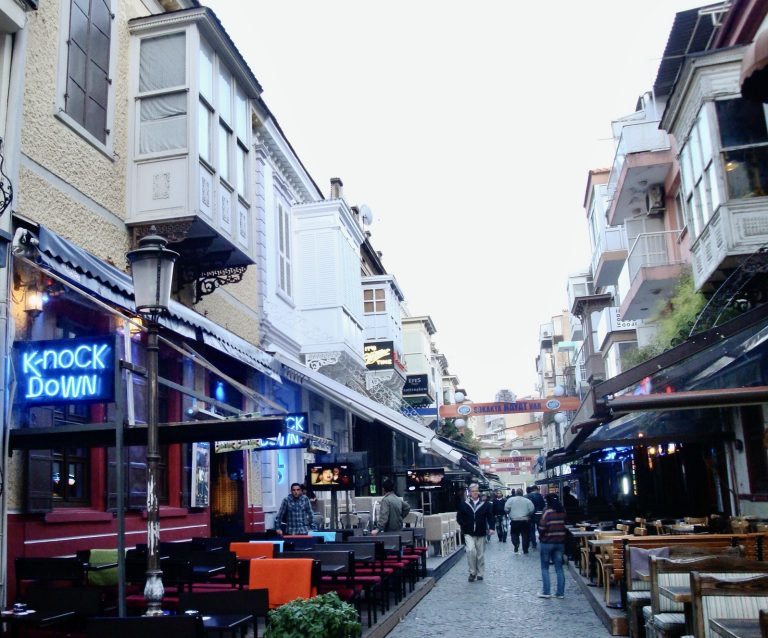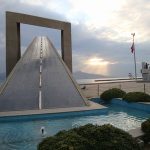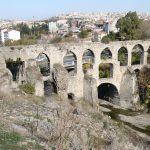It’s a bitingly cold evening in İzmir which comes as something of a shock to me who had always imagined its climate to be very mild. Not to be put off, I amble north along the Kordon to eat in Alsancak, and as I do so I vividly recall a previous visit years ago when the Kordon had only just been re-landscaped after an unbelievably foolish scheme to run a highway along the waterfront was finally consigned to the scrapheap. And what a relief that must have been to the occupants of the neat little apartment blocks that line it. Had that reprieve not come through, one minute they would have been enjoying priceless daily sunsets, the next facing concrete flyovers and relentless noise.
That visit had been in a February, a balmy February when the newly laid-out walking and cycle paths had been filled with İzmirlis enjoying the unseasonal sun. As it started to set I gazed enviously at all the cheery people strolling by with balloons in their hands, at the young couples sitting on the seawall to watch the sunset, at the phaetons clip-clopping past with couples snuggled up against each other inside them. What a happy place this is, I thought. So many happy people, so grateful for the new Kordon and what it has to offer. Only belatedly did the penny drop. It was 14 February! Sevgililer Günü, the Turkish equivalent of St Valentine’s Day which is celebrated with more and more enthusiasm here every year. Alas, I had been far too busy sightseeing to notice the date.
Today the Kordon was still busy with joggers and dog walkers although it was already starting to look a little frayed around the edges, attention to regular maintenance not being one of Turkey’s stronger points. At the far end I paused to admire the house that contains İzmir’s Atatürk Museum, one of fewer than half a dozen of the fine old mansions that once lined the Kordon to have survived the fire of September 1922. Then I cut inland for the labyrinth of narrow streets that makes up Alsancak.
Fortunately for İzmir, street upon street of the pretty little Chios-style stone houses with jutting out cumba (bay) windows also survived the fire. Now almost all of them are occupied by bars and restaurants, which is great if you’re in search of a night on the tiles but a little sad when you think what wonderful homes the houses might have made. One by one the streets are also being renamed, dropping the depressingly dull Soviet-style numbering system in favour of the names of artists, musicians and other celebrities. “Sokakta Hayat Var (There’s Life in the Street)” read banners thrown across the roads, and at once I remembered the same signs in Kadıköy in İstanbul. Those I had assumed a backhanded swipe at the local authorities who had recently had all the tables and chairs removed from the pavement cafes of Beyoğlu. Now I realised they might be nothing more political than a clever advertising wheeze on the part of Efes beer.
Whatever. Cumbalı Sokak in Alsancak reminded me forcefully of Kadife (Barlar) Sokak in Kadıköy. The same quaintness crossed with trendiness. The same young and fashionable clientele. The same back turned firmly on all the stereotypical images of “oriental” Turkey. I’d come here to dine at Jackson’s, a fine stone mansion that had apparently been home to the British consul at one time but had reckoned without Sunday closing and arrived to find its doors barred.
Jackson’s had looked big enough to offer comfortable anonymity to a solo female diner; in most of the alternative cafes I knew that I would stand out like a sore thumb. Disappointed, I turned onto pedestrianised Kıbrıs Şehitleri Caddesi, which reminded me of Kadıköy’s Bahariye Caddesi. The same line-up of small, inexpensive eateries. The same trendy clothes shops. The same steady buzz of small-scale commercialism.
Yes, I know I should have dug out a cute little local lokanta, a place with great food about which I could have raved in this blog. Instead, though, I chose the bright and busy Baydöner Restaurant, a branch of a small chain that I had never tried before but where I could be assured of decent enough food, smooth service and that much-craved anonymity. But, you know, I’m glad I did choose it anyway. Baydöner turned out to be one of those places, like nearby Kırçiçeği, that epitomised the new, more confident Turkey. Brightly lit, spotlessly clean, with highchairs available for babies, disposable table-mats that list all their other branches and waiters who rush your order to the table as if their life depended on it, it was frequented by a hugely varied clientele. Here there were young women eating alone, young men eating alone, young women eating together, older women eating together, couples eating together, even this one stray yabancı eating on her own. There were one or two headscarves but many more uncovered heads. The atmosphere was upbeat and positive. It was the perfect antidote to those doom-mongers who are always so sure that Turkey is just one election away from turning into Iran.
Written: 13 November 2011


